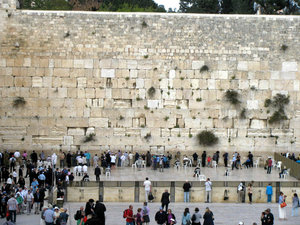Advertisement
Published: April 26th 2013

 Prayers at the Western Wall
Prayers at the Western Wall
People come here 24 hours a day to prayThe Temple Mount is one of the holiest sites in the Abrahamic religions. This was the site of the First Temple, built by King Solomon around the tenth century BCE. This temple was built on top of the location of the Foundation Stone, believed by Jews and Moslems to be the spiritual junction of heaven and earth. The temple stood for 410 years before being destroyed by King Nebuchadnezzar II. The First Temple contained the Ark of the Covenant, which contained the stone tablets of the Ten Commandments. Today, the Dome of the Rock stands on top of the Foundation Stone.
This is also considered to be the place where Abraham offered his son Isaac as a sacrifice before being stopped by an Angel of the Lord. This story is mentioned in the Koran, as well as in the Hebrew and Christian bibles.
The Second Temple was rebuilt by Herod, who also built the retaining walls surrounding the Temple Mount in 19 BCE, but what you see today is but a pale remnant of the walls of that era. To get a feel for what it looked like in its glory days, you need to go underground.
To get anywhere near the Western Wall you have to go through a metal detector. Of course, that means you also have to
find the Western Wall, which means navigating a warren of tiny shops set along a maze of narrow stone streets with shopkeepers imploring “Madam, my shop is here, come let me show you one thing.”
Why the Western Wall? Why not the Southern Wall or the Eastern Wall, they are both still there. Well, it’s like this: When Solomon built the First Temple, it had a special room, called the “Holy of Holies” for the Ark of the Covenant which was in the middle of the western retaining wall. Jews wanted to get as close as they could to the Holy of Holies when they prayed. It is said the Divine Presence never moves from the Western Wall. Today, only a portion of the Western Wall remains above ground, and that bit is toward the southern end of the wall.
When you enter the plaza in front of the wall you notice a chunk of it is partitioned off. The northern most part of the visible wall is reserved for men.
They get about 80% of it, including the part closest to where the Holy of Holies once stood. The southern, inferior, sliver is set aside for women with a high barricade between them. But here’s the kicker: the women actually have access to a part of the wall closer to the middle; they just have to go underground to get to it.
After the Six Day War in 1967, the Israelis began the project of exposing the entire length of the Western Wall. This was an enormous undertaking since much of the wall had been buried over the years, either as a result of invaders knocking over the wall, or folks throwing garbage in the valley. At the southern end, the existing wall is over 105 feet high, measuring down to the bedrock on which it was built.
Today, you can go down in the tunnels and see the original stones quarried in the time of Herod. Considering these folks didn’t have anything other than hammers, chisels, wheels, and levers, it is absolutely astounding they were able to build such as engineering marvel. Some of these blocks are up to 43 feet long and three feet
high. And this isn’t just rough hewn stone, either. It is finely chiseled, with an incised border, and so precisely cut that the stones were set without mortar and fitted so exactly that you cannot slip a piece of paper between them.
Walking through the tunnels you come across remnants of an old gate into the Temple Mount, an aqueduct, cisterns, and at the middle of the length of the Western Wall, closest to the Holy of Holies, a small carved out room. This room is reserved for women to come to pray.
A little further on, heading north, you come to a spot where the tunnel has been excavated down to paving stones of the street Herod had built next to the wall. I was so gob smacked by this that I admit to discreetly slipping off my sandals and standing barefoot on the stones. How cool is that!
As the tunnel continues north, you come to a point where you can see the foundation of the wall on the bedrock. You exit the tunnel by the Via Dolorosa, into the crush and confusion of tour groups following the Stations of the Cross.
For more about this tour see
http://english.thekotel.org/
Advertisement
Tot: 0.052s; Tpl: 0.011s; cc: 7; qc: 23; dbt: 0.0212s; 1; m:domysql w:travelblog (10.17.0.13); sld: 1;
; mem: 1.1mb




















